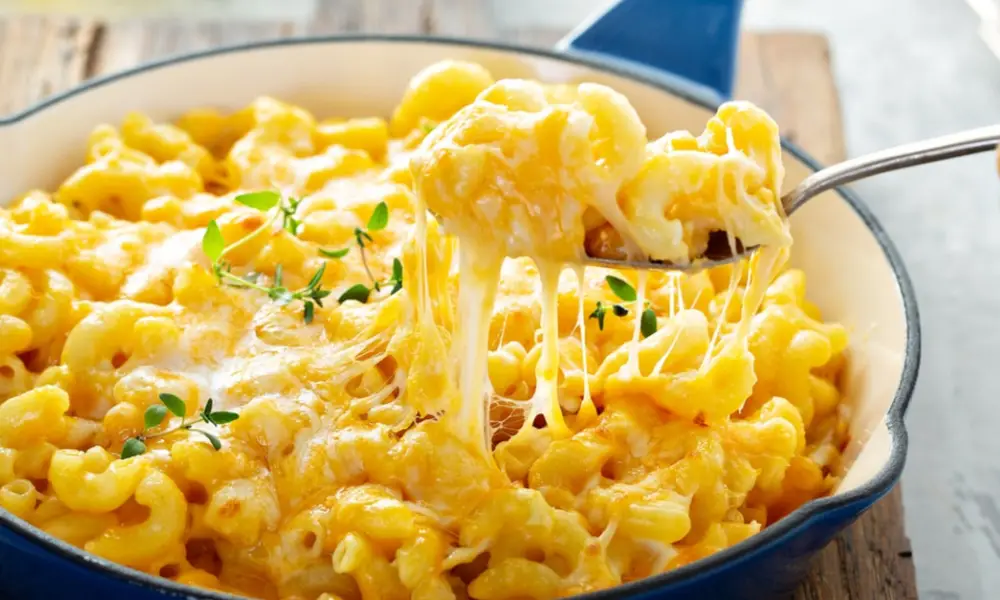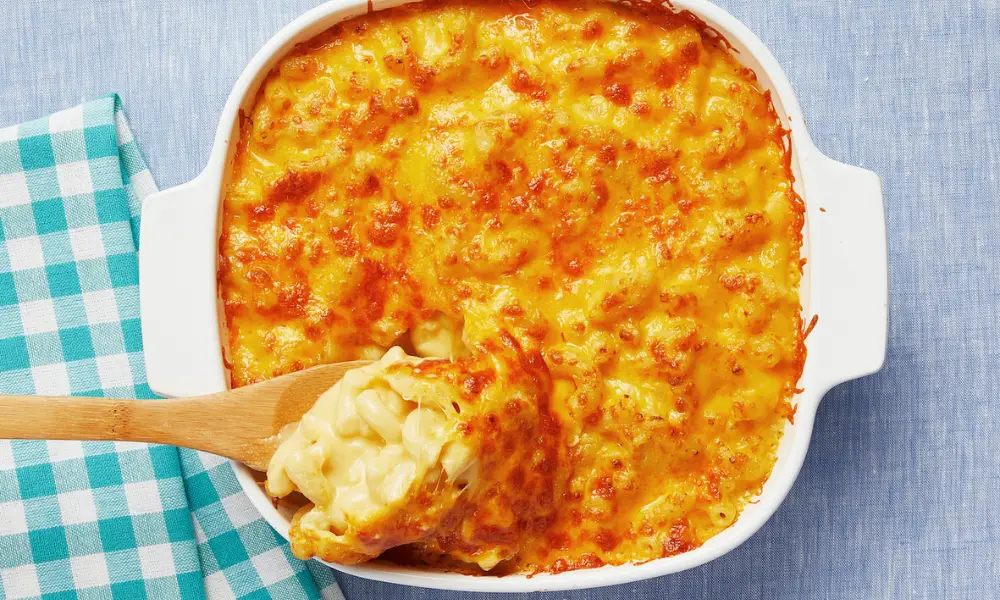If you are looking for an easy way to reheat mac and cheese, you may want to use the microwave or a crockpot. These two methods will retain the freshness and creamy texture of your dish, and in addition, they will keep the ingredients fresh and don’t compromise the dish’s nutritional value. So, read on if you want to enjoy your mac and cheese again without compromising its flavor!

How to Reheat Mac and Cheese?
Microwave
- Put the macaroni and cheese in a bowl that can be heated in a microwave. Only remove what you intend to use, please.
- For every cup of mac and cheese, add one tablespoon of milk.
- Half-and-half or cream can be used as a substitute to increase the flavor and smoothness.
- Cover with an inverted plate, using oven mitts to take it out of the microwave without getting burned.
- Put the dish in the microwave and heat it carefully. Start with one minute, stir the mac and cheese, and then heat it for an additional 30 seconds at a time until the required temperature is reached.
- Before heating in the microwave, throw some shredded cheese, broccoli, or delectable morsels for added taste.
Oven
- Put the macaroni and cheese in a dish that can go in the oven. Only remove what you intend to use, please.
- Add one tablespoon of milk to each cup of mac and cheese and thoroughly combine.
- Half-and-half or cream can be used as a substitute to increase the flavor and smoothness.
- Wrap the dish in aluminum foil and bake at 350°F for 20 to 30 minutes, or until well heated.
- Adding additional grated cheese, jalapenos, bread crumbs, or bacon pieces will give extra flavor or crunch. Return the dish to the oven until the cheese has melted or the bread crumbs have browned.
On the Stove
Here is a technique that reheats food faster than using an oven. The only drawback of reheating mac and cheese on the stove is that you must prepare it precisely and carefully follow these instructions to avoid having burnt mac and cheese. Small servings work best for this.
- Put your mac and cheese in a skillet or pot.
- Gently combine whole milk or the same kind of milk you used to make your cheese sauce with your mac and cheese. For every cup of pasta, use one tablespoon of milk.
- Reheat the mac and cheese over low to medium heat, stirring regularly but gently. To keep it moist, gradually pour in more milk. About 10 minutes will pass throughout this.
- After serving, turn off the heat in the pan.
- Don’t preheat your pan before reheating your mac and cheese on the stove since this could make the food burn! To distribute heat evenly, stirring continuously yet gently is crucial.
Baked Mac and Cheese Reheating Techniques
The most typical way to prepare mac and cheese is on the stovetop, but reheating would be a little different if you baked yours.
Reheating it in the oven is the best option for this. It will taste exactly like freshly made mac & cheese if you follow these instructions.
- Set the oven to 375 degrees Fahrenheit.
- Put the mac and cheese in a baking dish with little butter and foil over it.
- For 20 minutes, bake.
Serve
Similar to ordinary mac and cheese, you’ll want to skip the toppings if you reheat it.
Reheating Frozen Mac and Cheese
Mac and cheese are priceless, and you would help if you never threw away any leftovers when preparing food at home. Fortunately, mac & cheese can be frozen and reheated later without having to thaw it first.
- Even though it could take a while, the cheesy meal is always worth the wait!
- Set the oven to 350 degrees Fahrenheit.
- Take the mac and cheese out of the freezer and spread it in a baking dish.
- Bake for an hour to one and a half.
- Take it out of the oven after an hour to ensure it has heated all through. To make sure the bottom portion is also warm, use a spoon.
Your mac and cheese are prepared to serve after it reaches the ideal temperature and has a beautiful, creamy texture.
If you’re hosting visitors or have kids who always crave mac and cheese, freezing is an excellent method to save time!
How to Cut the Number of Calories in Mac and Cheese?
Rich, calorie-dense components like macaroni, cheese, and milk or cream are used to make mac and cheese. Some variations also use cream cheese or butter, which adds extra calories and fat.
Mac & cheese is a delicious dish to eat in moderation because of its rich components, but happily, there are simple substitutions you can make to cut the calories or make the dish healthier.
Here are some better alternatives to macaroni and cheese:
- Instead of ordinary macaroni, use high protein, high fibre pasta made from beans or chickpeas to boost the protein and fiber content.
- To cut calories and carbs, substitute broccoli or cauliflower florets for plain pasta.
- Boxed mac and cheese products’ “light preparation” instructions should be followed because they require less butter and milk.
- Add vegetables to the dish to enhance your mac and cheese’s fibre and nutritional value while lowering the calorie count per serving.
- Reduce the amount of cheese used in half and flavor the meal using herbs and spices instead.
- Replace milk and cream with unsweetened almond milk to potentially cut calories.
- Use Neufchâtel cheese instead of cream cheese because it has fewer calories and the same creamy, tangy flavor.
- Add chopped chicken breast or other lean protein sources, like tuna or beans, to make the recipe more full and higher in protein.
- Additionally, remember that you should consume mac and cheese in moderation and restrict your serving size to no more than 1 cup (about 150–250 grams) per serving because it is often rich and calorie-dense.
What is a Healthy Mac and Cheese Recipe?
This recipe for typical mac & cheese is healthier while still producing a luscious, creamy side dish.
You will Require:
- Elbows of dry 12 ounces (340 gram) chickpea pasta
- 28 grams of butter, or 1/8 cup
- 2 grams of xanthan gum, half a teaspoon
- 1 1/2 cups (360 ml) of almond milk without sugar
- 1 1/2 cups (360 ml) of vegetable or chicken broth
- Salt, 1/2 teaspoon
- 125 grams or 1 cup of grated cheddar cheese
Directions:
- Following the directions on the package, prepare the chickpea macaroni and set it aside.
- Melt the butter in a big pot until it starts to bubble a little. Mix the butter and xanthan gum thoroughly before adding.
- When the sauce has somewhat thickened, mix in the unsweetened almond milk, broth, and salt and simmer for 5 to 6 minutes, stirring frequently.
- Add the cheese shavings and stir until it melts.
- The cooked pasta should be added after you’ve thoroughly mixed the sauce.
There are approximately six 1-cup servings in this dish. Each serving includes:
- 314 calories
- 14 grams of fat
- 19 grams of protein
- 34 grams of carbs
- 8 grams of fiber
- NaCl: 583 mg
Chickpea pasta has more protein and fiber than ordinary macaroni, and replacing white milk with unsweetened almond milk reduces calories and fat.
This cheese sauce uses a modest amount of xanthan gum, a potent thickener purchased online or at natural grocers, as a thickening agent instead of refined white flour.
This dish is also gluten-free and is simple to adapt to become vegetarian or vegan by swapping the butter for olive oil and the cheese for a non-dairy cheese alternative. Replace the spaghetti with broccoli or cauliflower florets for a low-carb substitute.
The leftovers can be stored in your refrigerator for up to 5 days. You are welcome to use any of the recommendations mentioned above to reduce the calorie count or increase the nutritional content of this mac and cheese.
What is the Nutritional Data for Wide Varieties of Mac and Cheese?
Different amounts of calories are included depending on the brand, ingredients, and serving size of macaroni and cheese.
- Mac & cheese has a high-calorie count because of the enormous amounts of fat and refined carbohydrates it includes. Regardless of the source of the calories, eating more than you burn might result in weight gain.
- Mac and cheese also contain a lot of salt. It is advised that most people limit their daily intake of this mineral to no more than 2,300 mg, as exceeding this amount in some people may result in high blood pressure.
- The dairy-free brand Daiya “Cheezy Mac” offers the fewest calories, with only 300 calories per 1/3 container (100 grams), or around 1 cup of serving.
- It also has the most negligible salt content.
- However, as homemade mac and cheese is sometimes made with significant amounts of cheese, milk, cream cheese, or butter, both standard and gluten-free versions have the greatest calorie counts. In exchange, you have the choice to omit including more sodium.
- It would help if you only had mac and cheese in moderation or as an occasional treat as part of a healthy diet because these options have a high sodium and calorie content per 1 cup (about 150–250 grams) of food.
Conclusion
If you’re reheating leftover mac and cheese, you can add a tablespoon of milk to the dish, which will help retain moisture in the world. Cover it with plastic wrap or a damp paper towel to prevent overheating. Be sure to set the microwave to 50% power, which will heat the mac and cheese more slowly than 100% power. Be careful not to overcook the mac and cheese, as it can end up soggy.

